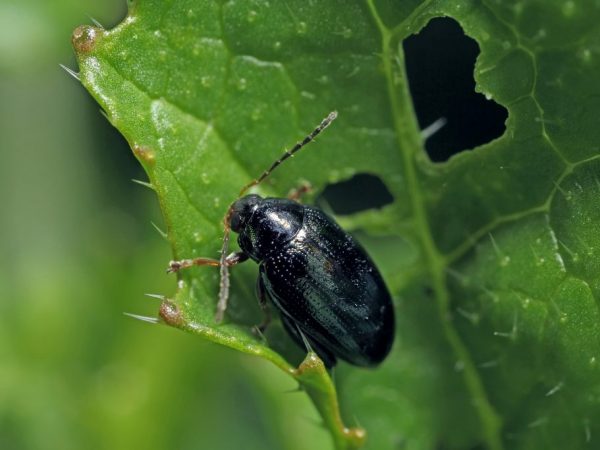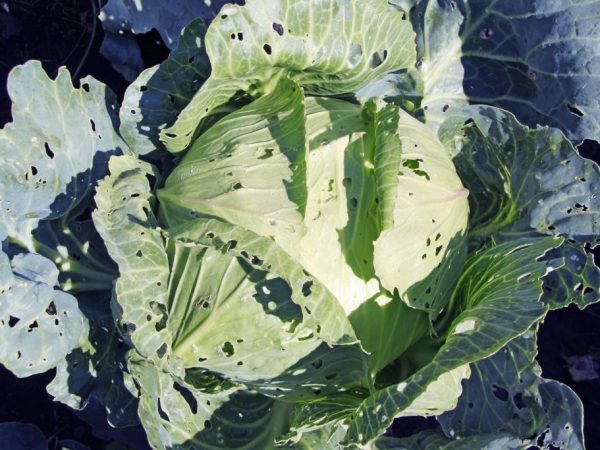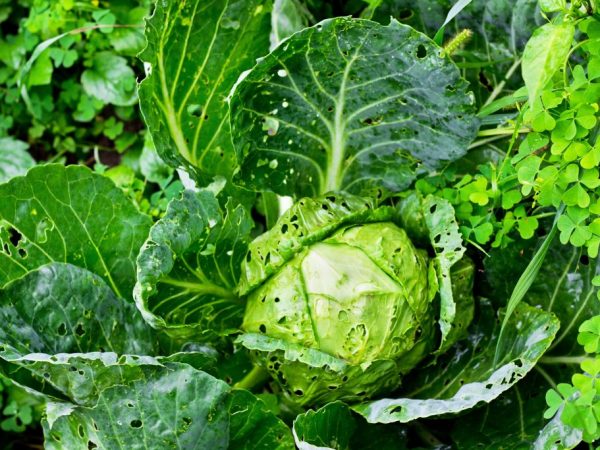How to deal with a flea on cabbage
Fleas on cabbage are not uncommon for gardeners. This voracious pest of black color from the order of leaf beetles can destroy young cruciferous seedlings in a short period of time. Consider how you can deal with the cabbage flea.

Flea control on cabbage
Biological description
The cruciferous black flea on cabbage is a small insect no more than 3-4 mm long with a shiny curved back. The beetle is distinguished by good jumping ability, provided by the thickening of the femoral parts of the hind legs.
A black cabbage flea awakens in the ground when the spring heat comes, when the average daily temperature is 15 ° C.
The cruciferous flea larvae develop in the soil, feeding on plant roots, in most cases on weeds. The larva turns into an adult in 2-4 weeks, pupating by the end of June. They can also hide from the cold weather and overwinter in greenhouse structures or in piles with last year's fallen leaves.
Signs of appearance and favorable factors
Small adult bugs that have appeared on cabbage plantings begin to eat up young leaves and stems, and their larvae damage the root system of plants. As a result of a massive invasion of cabbage fleas on cabbage, plantings can die in a few days.
You can determine that a black cruciferous flea has appeared on cabbage by changes in the appearance of the vegetable crop:
- under the destructive effect of the larvae in the soil on the root system, foliage in plants begins to wither and wither even with abundant watering,
- when adults of the cabbage flea appear, the cabbage foliage becomes covered with sores, gnawed by the interveins, and extensive gnawing of leaves.
As a result of severe damage to cabbage seedlings, the plants dry out and die.
Among the conditions that favor the active reproduction of the cabbage flea are hot sunny weather and no rain.
Agrotechnical measures
Correct agrotechnical measures can prevent the appearance and reproduction of the cruciferous flea on cabbage.
Landing dates
If the deadlines for planting cabbage seedlings are met, mass destruction of the plantings by the pest can be avoided. So, it is recommended to plant cabbage before and after the main stages of insect development. Early varieties of vegetables, which are planted in early April, and late varieties, which are planted in July, can avoid pest damage. By the time the adults are ready, such plants have time to develop and take root, and their foliage becomes coarse, which becomes unattractive to the pest.
Weeding

Unfavorable conditions attract pests
Timely cleaning of weeds makes it possible to create conditions for the pest unsuitable for living, reproduction and development.Therefore, it is recommended to thoroughly clean the area from plant residues in the fall, after the harvested vegetables.
Watering
Such a measure as abundant watering on hot days can create protection for cabbage plantings against an insect. The cruciferous flea does not like humid environments.
Phytoncidal neighbors
Planting phytoncidal plants, which include dill, garlic, coriander, can become measures to prevent the appearance of a pest in the beds. They create a specific smell that repels the pest.
Shelter
You can create protection for cabbage plantings in the fight against a cabbage flea with the help of covering materials, if you cover young seedlings with them until they finally take root and get stronger. Among such materials are spandbond, lutrasil and other non-woven fibers.
Folk recipes
Folk remedies are also effective methods in the fight against the cabbage flea, allowing you to quickly get rid of it.
Dusting
Dusting cabbage plantings with wood ash, tobacco or road dust, or ground red pepper makes them unattractive to an insect. Such components work effectively both independently of each other and in combined mixtures.
It is recommended to dust cabbage plantings or aisles in the morning, when dew is still on the plants, or in the evening after watering. The protective property of such products lasts until the first rain that has passed.
Spraying

Spraying with infusions will help get rid of insects
Among the effective folk methods of dealing with cruciferous flea beetles on cabbage are self-prepared infusions with which seedlings are sprayed:
- a mixture of tomato tops and chopped garlic, taken in equal proportions and diluted with a ten-liter volume of water with the addition of a small amount of soap for a bunch,
- tobacco (200g) diluted in 10 liters of water with a small amount of soap,
- wormwood (1 kg) boiled for 20 minutes together with garlic (100g), diluted after cooked to a volume of 10 liters,
- chicken manure diluted in water in a ratio of 1:20, fermented in the open air,
- vinegar (200 g of table solution or 2 large spoons of essence), diluted in 10 liters of water.
Chemicals
Traditional methods become ineffective when the defeat of cabbage plantings is large-scale. It is necessary to process the seedlings so that they are not finally eaten by the cruciferous flea, it is already necessary to use chemicals.
Bi-58
Bi-58, an insecticidal preparation for systemic action on insects, effectively fights against most pests, including effective against cabbage flea beetles. The active substance is diluted in 5 or 10 liters.
Decis
Chemical agent of universal action, used in the fight against a wide range of insect pests. To increase the effectiveness of its contact-intestinal effect, it is recommended to process plants at a steady temperature of at least 25 ° C.
Imidalite
A chemical product intended for the treatment of seeds before planting, capable of creating effective protection during their further cultivation.
Diazinon
Diazinon effectively protects the soil if the surface of the earth is treated with this preparation during the planting of cabbage seedlings.
Conclusion
The fight against the cabbage pest can only bring a positive result if it starts immediately. Examine the plant carefully so as to detect the pest in time and not completely lose your crop.


